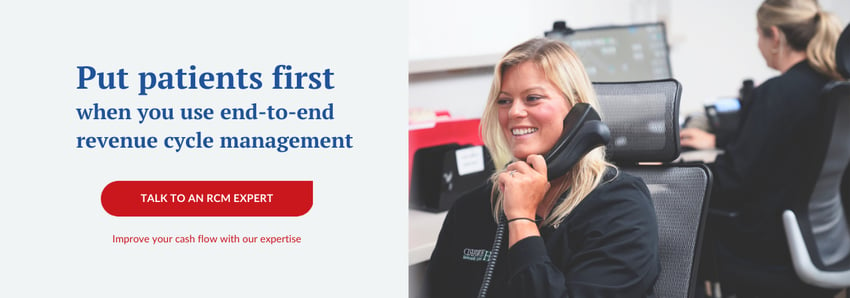If you’re in charge of the financial health of your practice, you want to keep track of certain dental KPIs (key performance indicators). You want to know where you are excelling, and what needs improvement. Knowing your dental KPIs will help you make choices and set goals for your dental practice.
But which dental KPIs best help you track the performance of your dental practice?
DCS is a trusted dental billing partner that works with dental teams to make revenue collection easy, leading to positive trending dental KPIs. Through our experience working with dental teams, we’ve seen which dental KPIs give you a clear picture of practice health.
That’s why we’re sharing 5 dental KPIs to track at your dental practice. These KPIs will help you steer your practice toward success as a business. Having cash flow you can count on gives you the means to excel, treat more patients and keep them coming back to you for your great service and experience.
1. Practice production
Your dental practice production is the amount of revenue generated for treatments completed for patients. How many patients you treat per day is likely something you already track. You can tell when some days or times of year are busier than others.
Gross production shows you the total production you’ve generated according to your fees. Net production reflects production after the adjustments for PPO write-offs and other adjustments or discounts. Keeping track of production allows you to make sure it is steadily increasing and is one of the most important dental KPIs to monitor. In most practices, a healthy net production should be equal to the net collection with the exception of orthodontic payment plans.
Related: 3 ways to avoid a drop in dental collections during the holidays
If you begin to see a dip in production during a certain time of year, or in general, watching your production KPI can help you take steps to fill your dental chair and gain new patients.
2. Dental collections - Insurance and patient
After you treat a patient, you need to check that you get all due payments. Your collections reflect the total revenue that you actually receive. The fees for services you provide are typically covered by patient payments and insurance claim payments. So your collections are coming from two different sources, and tracking those numbers tells you how much earned revenue your billing systems bring in.
Do your patients pay their estimated portion on the date of service or do you send them a bill? If your production is high, and your patient collections are low, you may want to review your current financial policy and patient financial arrangements when the treatment plan is discussed with the patient.
Sometimes adding a new patient payment method helps to ensure you are getting paid for your services. When you mail a bill to your patient, they are more likely to ignore it, leading to low patient collections.
Then there are your insurance collections. Collecting from insurance presents a different challenge because the amount they will pay for a treatment can be unpredictable sometimes. And when an insurance claim is denied, you have to work to figure out the reason for the denial, then work to appeal the denial.
A good rule of thumb is to make sure that your dental claims that are over 30 days old do not exceed 10% of the total amount of outstanding claims 0+ days old. In other words, a great KPI goal is to keep 90% of your insurance claims outstanding in the current claims category and no more than 10% of the outstanding claims over 30 days past due.
With a streamlined insurance billing process, you will have fewer claim mistakes leading to steadier insurance income and you’ll minimize insurance accounts receivable.

3. Scheduled patients
Another important dental KPI to track is your number of scheduled patients. This means you have patients on your appointment book who have accepted treatment recommendations from you, and show up for their appointment to complete their scheduled treatment.
Keeping your schedule full, and organized and with very little no shows or last-minute cancellations is a crucial part of running a smooth dental practice. It ensures your team is prepared ahead of time for each patient to come in, and it can also help you project the daily production amount.
You can also track unscheduled patients via most practice management software programs. If you see your number of unscheduled patients is high, reevaluate the manner in which you educate your patients on their plan of treatment and the financial arrangement or agreement options available.
Make sure you have a system in place for how you explain the urgency of dental treatment to your patients, and how putting off that treatment can lead to more extensive and expensive treatment.
4. Practice overhead
You’re running a business, so you’re going to have several dental practice overhead expenses. Keeping track of these overhead expenses is important to know so that you understand where a large portion of your money is going.
More commonly than not, overhead expenses that are fixed may be difficult to cut or reduce. But there are always changes you can make in order to decrease your variable overhead expenses.
And that’s why you should keep track of your Profit & Loss Statement as this KPI. Reevaluate the importance of each of these overhead expenses, and strategize with your CPA or Dental Consultant on reducing your overhead and increasing your profits.
Most dental CPAs will share with you the statistics for the average overhead percentages for dental practices that are similar to yours by comparing the expense based on the revenues for the evaluated time period.
Prioritize the expenses that are profitable or make your practice run more smoothly, and cut overhead expenses that are outdated or less productive.
Related: How to prioritize dental practice expenses: What’s most important?
For example, are you still mailing statements to patients? Go paperless and start automating your patient billing. Use an online portal or email patients their dental documents. It can save you on printing and postage expenses.
5. Patient retention
The rate at which your patients stay with your dental practice is your patient retention KPI.
This means they repeatedly come back to your dental practice, and continuously schedule their next appointment with you. Having loyal patients stay on their regular recare cycle is a great way to maintain your patient’s dental health, improve your practice cash flow, but also get new patients.
Keeping your current patients happy with your services and their experience is crucial. And if your regular patients have an amazing experience with you every time, they’re going to tell their friends about your practice.
Keeping track of your patient retention number can let you know if something about the patient experience is or is not working. For example, if you’re seeing this number drop, talk to your dental team and see if anything has changed about the experience your patient has from when they walk through the door to when they leave after their treatment.
Ready to get healthier dental KPIs with outsourced dental billing services?
Tracking your dental KPIs is the best way to know how different elements of your dental practice are affecting its success as a whole. Knowing your production, collections, scheduled patients, overhead and retention numbers can help you strategize different ways to improve or maintain your financial and professional performance.
Outsourcing your dental billing services is a great way to collect more for lower costs. When you work with a company like DCS, you can have a clear, accurate, and compliant billing process. This will make running your practice easier and more profitable, leading to healthier KPIs.
To learn more about how outsourcing your dental billing can improve your numbers, schedule a call with one of our experts.

Related Posts
Dental revenue resources from Dental Claim Support
-1.jpg)


